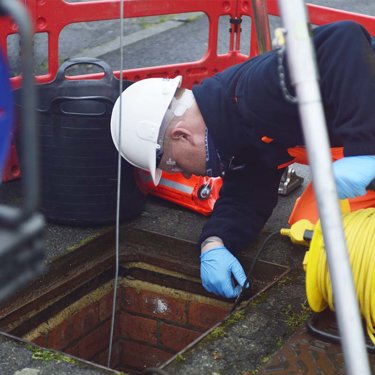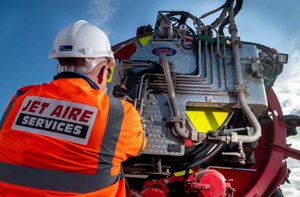
Trenchless lining and patch repair
We employ trenchless technologies to repair damage and joints in pipes, drains or sewers, preventing leaks, floods and environmental damage without the disruption, expense or emissions associated with excavation.
Following a CCTV survey to evaluate the condition of the pipe, our experienced engineers assess the site and local environment and calculate the most appropriate solution.
Robotic cutters are used to open any laterals that are covered up when a liner or patch is installed, to reconnect services and prevent flooding. In addition, they are employed when there is an item in a drain run that cannot be removed using our high-pressure water jetting attachments.
Features
- We can line drains and sewers of any shape or diameter.
- Over 150,000km of drainage already lined.
- Pre and post-surveys ensure the work is carried out accurately and to a high standard.
- State-of-the-art equipment includes patching vans, UV curing systems, robotic cutters, camera systems, jet-vacs, LED curing systems, inversion systems, dragging systems and pressure main systems.
Added value
Expertise
Longetivity and increased capacity
Efficient
Complete solution
Safety
Cured-in-place pipe (CIPP) lining
Cured-in-place pipe - or CIPP - lining creates a new, smooth pipe inside the existing pipe to prevent further leaks or damage. It is used when the issues with the drain run are too numerous to install localised patches, or it is more cost-effective to line the whole pipe.
By providing a super-smooth interior surface, liners remove any rough areas that can cause debris to build up, helping to not only restore flow capacity in your pipes but improve it.
A flexible tube, infused with resin, is pulled through the pipe and inflated with air, forcing the resin against the host pipe. The resin fuses with the existing pipe wall and is cured using hot water, ambient, UV light or blue light methods to create an impermeable bond.
There is no digging involved as the relevant section can be accessed from manholes, and the revolutionary technology can be fed through to the affected area.
There are a number of different types of liner, each suitable for different situations.
UV lining is the fastest and most efficient type of lining and because no water is required, there is virtually no risk of environmental pollution.
The sewer liner is impregnated with light-sensitive resin and a specialist UV light train is pulled back through the run to cure the resin. It can be used on pipes between 150mm and 1800mm but is restricted to straight runs.
LED lining works in the same way to UV lining, but uses a blue LED bulb rather than UV light to cure the liner. The smaller bulb means it can be used in smaller pipes and on up to 90o bends.
The resin-impregnated liner is installed using a compressor and an inversion drum and is cured by the external temperature. This method is quick and is ideal for managing existing flows. It can be done from one access point.
A hot cure liner can be used on any diameter of pipe and go around bends. A resin-impregnated liner is inserted into the pipe and inverted through to the next manhole. The liner is filled with water, which is heated to around 85 degrees and circulated for 4 hours until the liner is cured. Once cool, the liner is cut to release the water so that the liner can be trimmed and any lateral connections cut.
Our pressure pipe lining is designed for use in highly pressurised pipelines carrying firewater or gas, such as rising mains. Unlike other liners, our solution is self-supporting and doesn’t require curing.
Cured-in-place repair (CIPR)
CIPR provides localised spot repair for minor defects. It is a fast, economical, and robust solution to remediate pipes with specific defects, leaving a smooth impermeable finish. The resin is minimal shrinkage making it the ideal solution for preventing water leakage.
Patch repairs are used when there is localised damage such as cracks or root ingress. The patch consists of a length of glass fibre matting, which is coated in resin.
To install the patch, the matting is rolled around a “packer”, which is then pulled through the pipe run until it is situated at the correct place. The packer is then inflated, forcing the patch to adhere to the pipe wall. Once the patch has cured, the packer is deflated and removed, leaving the patch in situ.
Lateral sealing is an ideal solution for sewers with multiple junctions. It can be applied proactively to reduce leakage or pollution events or reactively at damaged junctions. It provides a watertight solution, preventing infiltration at the connection.
Robotic cutting
This highly specialised technique is used for reopening lateral connections and putting the sewer back into operation. Precise and controlled cutting of defective pipework, hard deposits, root ingress, and encrustation is used to remediate underground sewer and drainage systems.
The robotic cutter is remotely operated and equipped with cutting tools, such as high-speed rotating blades, to remove obstructions, roots, and other debris, as well as to trim, shape, or repair damaged sections of pipes.
It allows for accurate and targeted pipe maintenance without the need for extensive excavation, reducing costs and minimising disruption to the surrounding environment.
No-dig installations
The use of pneumatic moling and directional drilling techniques allow for the installation of pipes or ducting where excavation is not possible or would cause significant disruption, for example under roads and water courses, or in environmentally sensitive areas. The methods are fast and efficient resulting in less disruption and environmental impact.
You might also be interested in...
Here to keep your drainage flowing freely
Our experts are available now to help you understand and improve the condition of your drainage.
Speak to our experts




